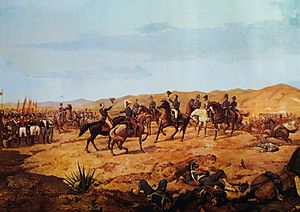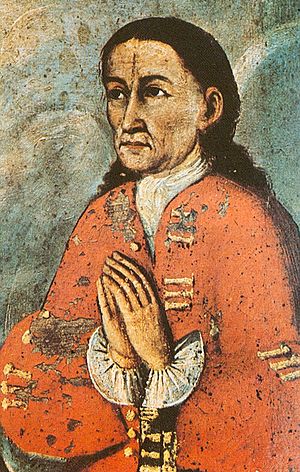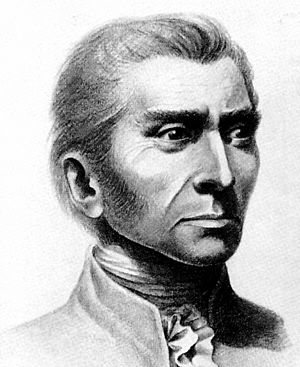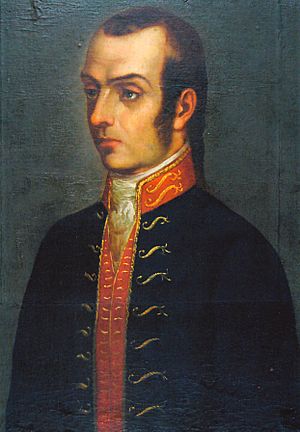Peruvian War of Independence facts for kids
Quick facts for kids Peruvian War of Independence |
|||||||
|---|---|---|---|---|---|---|---|
| Part of the Spanish American wars of independence | |||||||
 The Battle of Ayacucho Painting by Antonio Herrera Toro |
|||||||
|
|||||||
| Belligerents | |||||||
|
Patriots: |
|||||||
| Commanders and leaders | |||||||
|
|
||||||
| Units involved | |||||||
| Pro-independence militias United Liberating Army |
Royalist Army | ||||||
| Casualties and losses | |||||||
| About 20,000 dead people in total. 6,000 civilians (Spaniard population of Peru) killed or expelled. | |||||||
The Peruvian War of Independence was a series of battles in Peru from 1809 to 1826. It began with early victories by the Spanish army in 1809 and 1811. The war ended with the final defeat of the Spanish Army in 1824 at the Battle of Ayacucho. It finished completely in 1826 with the Siege of Callao.
This war was part of the larger Spanish American wars of independence. It was a long process of social changes, uprisings, and military conflicts. The main goal was to make Peru politically independent from the Spanish monarchy. This led to the creation of the Peruvian Republic.
Before this war, there was a big uprising in 1780-1781 led by an indigenous leader named Túpac Amaru II. This showed that many people in Peru wanted change. The Spanish rulers, called "viceroys," often had the support of rich families in Lima. These families worried that popular rebellions would threaten their power. For a long time, Peru was a strong base for the "Royalists," who supported the Spanish king. They fought against those who wanted independence in Peru, Bolivia, Ecuador, and Chile.
A very important moment in the war was when José de San Martín declared Peru's independence on July 28, 1821.
Contents
History of Peru's Fight for Freedom
The desire for independence in Peru started very early, even when the Viceroyalty of Peru was first created. For centuries, people protested against Spanish rule. Some of these protests turned into big rebellions.
One major reason for unhappiness was the Bourbon Reforms. These were new rules from Spain that often made life harder for people in the colonies. This led to the Rebellion of Túpac Amaru II. Even though this rebellion was stopped by the Spanish, the feeling of discontent remained. This was one of the first times colonial records used the word "insurgents" for people fighting for change.
Early 1800s: Spain's Troubles and Peru's Rebellions
In the early 1800s, France invaded Spain. The Spanish kings, Carlos IV and his son Fernando VII, were forced to give up their throne to Napoleon Bonaparte. Napoleon then made his brother, Joseph Bonaparte, king of Spain.
Because of this, people in Spain started their own fight against the French, called the Peninsular War. In Spanish America, many areas created their own local governments, called "juntas." These groups wanted to rule themselves, but they didn't always want to break away from Spain completely.
The Spanish viceroy in Peru, José Fernando de Abascal y Sousa, made the Peruvian army the main force against these independence movements. He fought against patriots in places like Upper Peru (now Bolivia), Ecuador, Chile, and Argentina.
The first Peruvian rebellions for self-rule happened in 1811. These were often led by indigenous people and supported by some local-born Spaniards, called "Creoles." Many uprisings happened in different parts of Peru, like Tacna, Huánuco, and Cuzco. Even though these early rebellions didn't achieve full freedom, they kept the idea of independence alive. Small groups of fighters, known as "guerrillas" and "montoneras," continued to resist until bigger armies arrived.
Peru's Role in the Independence Movement
During the Peninsular War (1807–1814), Spain's central government was weak. Many regions in Spanish America formed their own local governments. The viceroy of Peru, José Fernando de Abascal y Sousa, was very important in stopping uprisings in Upper Peru. He also defended the region from armies sent by the new governments in Argentina.
Because of his success, Upper Peru was added to the Viceroyalty of Peru. This helped merchants in Lima because trade from the silver-rich region now went through the Pacific. This is why Peru remained very loyal to the Spanish king for a long time.
Peru was one of the last places in South America to gain independence from Spain. It finally became free after major military campaigns led by José de San Martín (1820–1823) and Simón Bolívar (1823–1825).
Some of the first Spanish explorers in Peru even tried to gain independence from the Spanish crown. They wanted to be free from the viceroy, who ruled for the king. Throughout the 1700s, there were many indigenous uprisings against Spanish rule and how they were treated. The Bourbon Reforms made people even more upset, leading to the Rebellion of Túpac Amaru II. Even though it was stopped, the reasons for the indigenous people's unhappiness remained.
The independence of Peru was a big part of the Spanish-American wars of independence. After Peru became independent, other Spanish strongholds also fell. In April 1825, the campaign in Upper Peru ended. In November of the same year, the Spanish fort of San Juan de Ulúa in Mexico surrendered. Finally, in January 1826, the Spanish forts in Callao and Chiloé in South America also fell. Spain officially gave up all its American territories ten years later in 1836.
Early Rebellions and Uprisings (1811-1820)
Even though Peru was mostly loyal to Spain, some movements for self-rule, called "juntas," did appear. There were clear differences between Upper Peru and Southern Peru, especially in mining. Southern Peru often suffered economically, which caused protests from mining leaders in 1804. This was the start of unrest.
Political problems grew after the Spanish monarchy collapsed in 1808. Between 1809 and 1814, Cuzco and the southern provinces of Peru were politically unstable. This was a confusing time after Spain tried to create new ruling bodies like the Junta Central.
The first important armed rebellion happened in June 1811 in Tacna. It was led by Francisco Antonio de Zela. This rebellion showed that people in southern Peru wanted to reunite with Upper Peru. It also proved that people in the southern provinces, no matter their social class or background, were more united than those in Lima. This was important because it showed that their shared belief in Peru's independence was stronger than their differences.
Another important movement, led by Native people in Huánuco, started on February 22, 1812. This protest was partly inspired by ideas from Argentina and was also against corrupt local governments. These governments had unfair policies that hurt indigenous merchants. The rebellion lasted three months and, like the Tacna movement, brought together people from different backgrounds in southern Peru. It showed that rebels were against Spanish rule. Many leaders, including local chiefs (curacas) and town magistrates (alcaldes pedáneos), were involved, but the rebellion was stopped within a few weeks.
The Cuzco Rebellion (1814-1815)
The rebellion in Cuzco from 1814 to 1815 was more lasting.
It began with a fight between the local council (Cabildo) and the Spanish court (Audiencia) in Cuzco over how the city was run. The rebellion spread quickly. The main leaders of the 1814 movement wanted power for themselves, independent from Spain. They also disliked King Fernando VII and felt that promised reforms were not being applied.
Local-born Spanish leaders (Criollos) asked a retired general, Mateo Pumacahua, to join them. Pumacahua, who was in his 70s, had helped stop the Rebellion of Túpac Amaru II decades earlier. His decision to join the independence cause was a big change. The rebellion tried to spread its efforts towards Lima and Upper Peru to gain more support. This movement also highlighted how useless the viceroy's position had become.
Pumacahua joined the Creole leaders in forming a local government (junta) in Cuzco on August 3. They demanded that the liberal reforms of the Spanish Constitution of 1812 be fully put into practice. After some victories in southern Peru and Upper Peru, the rebellion was crushed by mid-1815. Spanish forces and loyal local chiefs took Cuzco and executed Pumacahua.
Liberation Armies: San Martín and Bolívar
José de San Martín and the Southern Liberation Army
After the Cuzco rebellion was put down, the Spanish viceroy in Peru sent two armies to fight the Chilean Patriots. In 1814, the first army successfully took back Chile after winning the Battle of Rancagua. In 1817, the Spanish lost the Battle of Chacabuco. A second Spanish army tried to restore the monarchy in Chile in 1818. They won the Second Battle of Cancha Rayada at first, but were finally defeated by José de San Martín at the Battle of Maipú.
To free Peru, Argentina and Chile signed a treaty on February 5, 1819. They planned an invasion. General José de San Martín believed that Argentina's freedom would not be safe until the Spanish stronghold in Peru was defeated.
The Peruvian Campaign Begins
Two years after the Battle of Maipú, which freed Chile, the patriots started preparing a sea invasion force to free Peru. Chile and Argentina were supposed to share the costs. However, the Chilean government, led by Bernardo O'Higgins, ended up paying most of the expenses. It was decided that José de San Martín would lead the land army, and Admiral Thomas Alexander Cochrane would command the navy.
On August 21, 1820, the Peruvian Liberation Expedition sailed from Valparaiso, Chile. It had 4,118 soldiers. On September 7, the expedition arrived at Pisco Bay and captured the area the next day. The Spanish viceroy tried to negotiate with San Martín, but talks failed by October 14.
First Battles and Independence Declaration
Actual fighting began with the Sierra Campaign, led by General Juan Antonio Álvarez de Arenales, starting on October 5, 1820. During this campaign, General Arenales declared the independence of Huamanga (now Ayacucho) on November 1, 1820. He then defeated a Spanish army at the Battle of Cerro de Pasco.
Meanwhile, Admiral Cochrane's forces captured the Spanish ship Esmeralda on November 9, 1820, which was a big blow to the Spanish navy. On December 2, 1820, a Spanish army battalion switched sides and joined the patriots. By January 8, 1821, General Arenales's troops rejoined the main expedition on the coast.
Viceroy Pezuela was removed from power and replaced by General José de la Serna on January 29, 1821. In March 1821, patriot forces attacked the Spanish ports of Arica and Tacna. The new viceroy announced he would leave Lima on June 5, 1821. However, he ordered a group of soldiers to stay and fight the patriots in the Real Felipe Fortress. This led to the First Siege of Callao. The main Spanish army, led by General José de Canterac, left Lima and went to the highlands on June 25, 1821. General San Martín sent General Arenales to watch the Spanish retreat. Two days later, the Liberation Expedition entered Lima. Fearing violence, the people of Lima asked General San Martín to enter the city.
Once in Lima, General San Martín invited everyone to swear loyalty to the cause of independence. The Act of Independence of Peru was signed on July 15, 1821. Manuel Pérez de Tudela wrote this important document.
San Martín Leaves Peru
José de la Serna moved his headquarters to Cuzco. He sent troops under General Canterac, who arrived in Lima on September 10, 1821. Canterac successfully joined forces with General José de La Mar's soldiers, who were trapped in the Real Felipe Fortress. After hearing the viceroy's new orders, Canterac left for the highlands again on September 16. The republican forces chased the retreating Spanish until they reached Jauja on October 1, 1821.
After an argument with General San Martín, Admiral Cochrane left Peru on May 10, 1822. Martin Guisse took over as head of the navy. The war slowed down after the Spanish army won a big victory at the Battle of Ica in April 1822. In October 1822, the republicans, led by General Rudecindo Alvarado, suffered another costly defeat.
In the north, Antonio José de Sucre in Guayaquil asked San Martín for help. San Martín agreed and sent an army to Quito. Later, during the Entrevista de Guayaquil, San Martín and Bolívar discussed Peru's future. San Martín preferred a king with a constitution, while Simón Bolívar (leader of the Northern Expedition) wanted a republic. However, both agreed that Peru should be independent from Spain. After this meeting, General San Martín left Peru on September 22, 1822, and gave full command of the independence movement to Simón Bolívar.
Simón Bolívar and the Final Push for Independence
After Peru declared independence, the new Peruvian state struggled with Spanish resistance and its own instability. While the coast and Northern Peru were controlled by the republic, the rest of the country was still under Spanish control. Viceroy La Serna had set up his capital in Cuzco. Another campaign against the Spanish, led by General Santa Cruz, was defeated.
The war would only end with military help from Gran Colombia. After San Martín left, and with constant military defeats under President José de la Riva Agüero, the Peruvian congress asked Simón Bolívar for help in 1823. Bolívar arrived in Lima on December 10, 1823, with the goal of freeing all of Peru.
In 1824, an uprising in the Spanish camp in Alto Peru (modern Bolivia) helped pave the way for the final battles. The Peruvian Army won the Battle of Junín under Simón Bolívar's direct command. They then won the decisive Battle of Ayacucho under the command of General Antonio José de Sucre. The war finally ended when the last Spanish strongholds surrendered the Real Felipe Fortress in 1826.
What Happened After Independence?
Peru was no longer ruled by Spain, but it still relied on Europe for its economy. Even after gaining freedom, the taking of land from indigenous people actually got worse in the new republic. Indigenous domestic workers were treated very badly, even into the early 1900s. However, indigenous people were given full citizenship in Peru on August 27, 1861.
After the war, different groups in Peruvian society had conflicts of interest. Also, the personal goals of individual military leaders, called "caudillos," made it very hard to organize the new country. Only three civilians became president in the first seventy-five years of independence. In 1837, the Peru-Bolivian Confederation was formed, but it broke up two years later due to military action by Peruvian patriots.
See also
 In Spanish: Independencia del Perú para niños
In Spanish: Independencia del Perú para niños
- Royalist (Hispanic American Revolution)
- Bolivian War of Independence
- Higgins, James (editor). The Emancipation of Peru: British Eyewitness Accounts, 2014. Online at https://sites.google.com/site/jhemanperu






